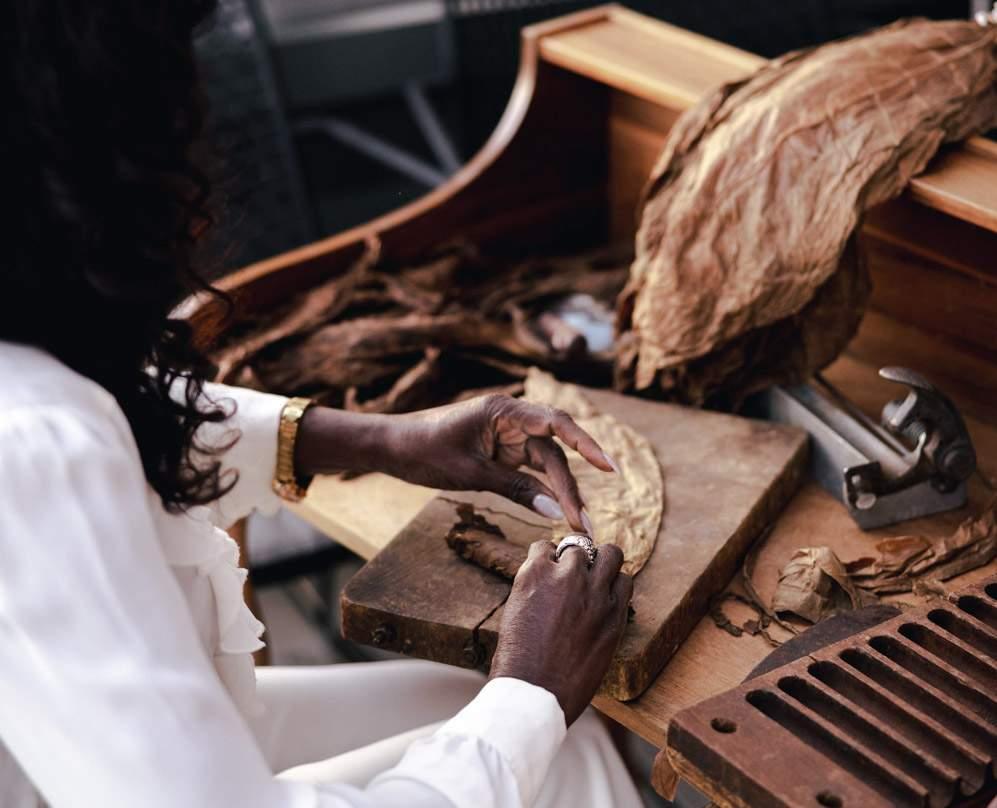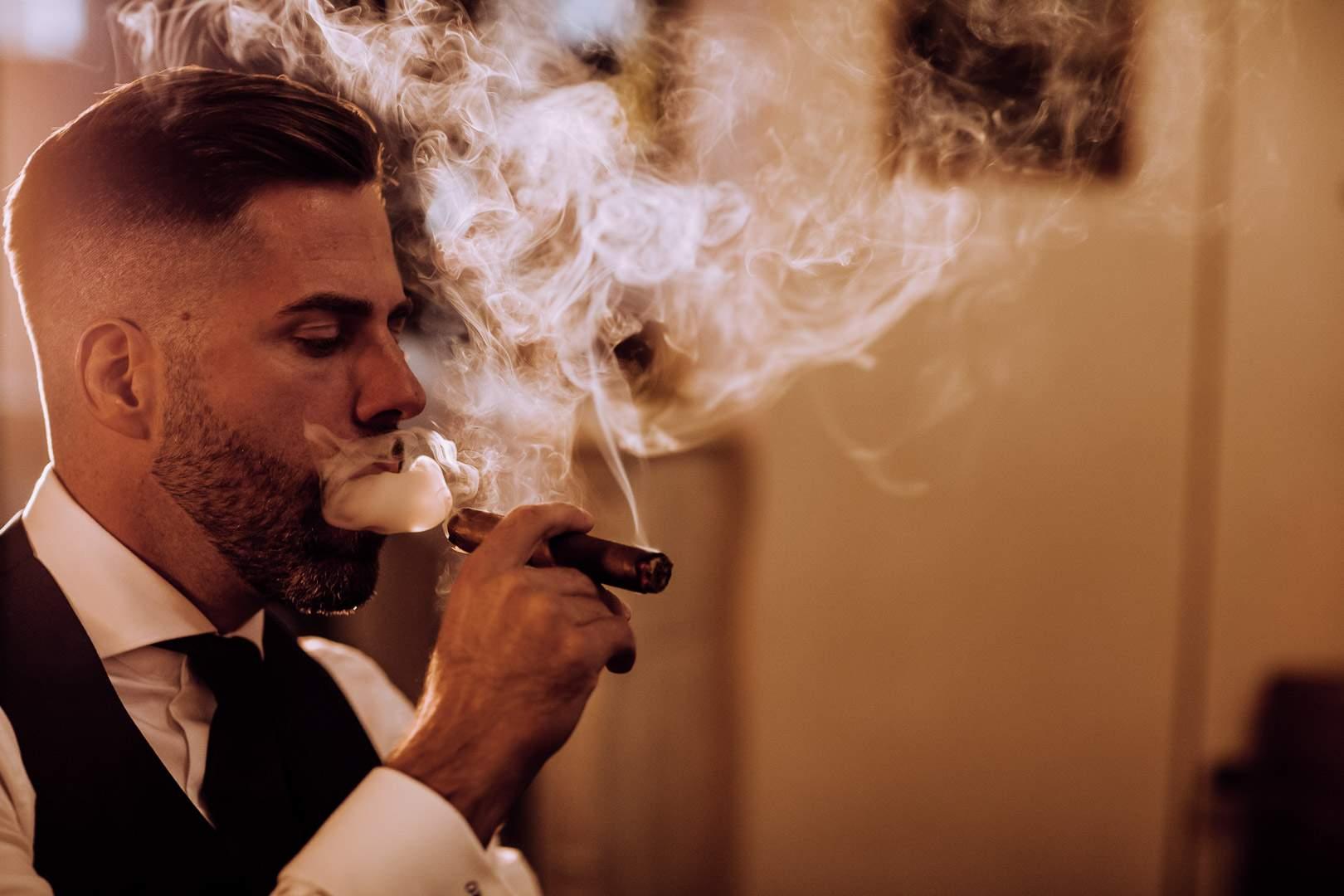Many production facilities in Central America and the Caribbean still roll cigars by hand as they did two hundred years ago. The Torcedoras and Torcedores make between 80 and 160 cigars per day. Learn more about the craft, the Torcedoras and Torcedores, as well as their entertainment when rolling cigars.
Neither VILLIGER nor other European cigar manufacturers in Europe still roll cigars by hand. The approximately nine months’ training to become a Torcedora or Torcedor have to be completed in one of the cigar factories of a manufacturing country. In most production companies, the future Torcedoras and Torcedores sit in the back rows of the factory.
Preparing and stripping leaves
As with cooking, proper preparation is helpful and vital. Thus, the Torcedoras and Torcedores place and sort their tools and the required ingredients on the work table. A cigar is made of three ingredients: the filler, the binder, and a wrapper. All three types of tobacco leaves are first moistened and then threshed – the central stem is removed from the leaves. The myth that cigars are rolled on the thighs of virgins stems from the fact that once the tobacco arrives at the factories, i.e., before it is processed, a group of women sorts the tobacco leaves by size, color, and texture. They also use their thighs for this.

Roll filler into wrapper
Once the ingredients and tools are prepared, the rolling can begin. For this, the Torcedoras and Torcedores take a suitable binder from the “tobacco packet” for the day and place it with the tip of the leaf towards the end of the cigar that will be lit. The tobacco flavor is not as strong there, making the smoke more intense over time.
Afterward, they arrange three to five different tobacco filler leaves in one direction. They do so to create fine air channels through which the smoke can circulate. The filler leaves are folded into a bundle and rolled tightly into the wrapper but not too tight. It is probably the most delicate process, which requires a fine touch from the Torcedoras and Torcedores. If it is rolled too tight, the draw resistance becomes too great, and it will not be enjoyable to smoke. Suppose a Torcedora and Torcedore is rolling it too loosely. In that case, the burn will be uneven and the draw resistance too low. In this case, the cigar burns too quickly and does not feel firm enough.
Pressing and rolling the wrapper
The combination of filler leaves wrapped in a binder leaf is also called a bunch. This bunch goes into a cigar press for 15 to 30 minutes, where it is pressed into its final form. Afterward, the Torcedoras and Torcedores trim off excess leaves at both ends of the cigar.
The last step involves rolling the wrapper leaf around the bunch. While the bunch consists of several leaves, the wrapper consists of a single leaf only. Nevertheless, the wrapper is essential for the taste, color, and quality of the final product. The slightly damp wrapper is laid out with the veins facing up and cut into a crescent shape. The wrapper is used to seal the cigar’s head using special glue. Alternatively, a small part of the wrapper can be punched out to finish off the cigar head. In the end, the Torcedoras and Torcedores use a guillotine to cut the burning end into shape and place the finished cigar with the other works of art in bundles of 50. These are then labeled with the number of the Torcedoras and Torcedores, the cigar brand, format, and date of manufacture. These large bundles of freshly rolled cigars are then moved to one of the factory’s numerous aging rooms, where they are left to mature for about three months.

On-site quality assurance
Torcedoras and Torcedores can produce between 80 and 160 cigars per day, depending on experience, cigar format, and rolling difficulty. The salary of the cigar rollers is also determined based on the number of flawlessly accepted works of art. There are various levels of quality assurance to ensure the quality of tobacco products. Plant managers supervise the performance of their Torcedoras and Torcedores. They check the work of each department in terms of techniques, manufacturing quality, and dimensional accuracy. In many places, modern Draw Master technology is used. These are technical devices that use gas pressure to check the draw resistance of the rolled filler.
Afterward, the bundles of cigars are taken to a separate quality control room where experts inspect them for weight, length, diameter, strength, manufacturing quality, and appearance. Through random sampling, some cigars are opened to examine their internal structure and blend.
Quality assurance in Europe
While there are no Torcedoras and Torcedores in Europe and VILLIGER only produces machine-made cigars or specialties in Europe, such as the VILLIGER ORIGINAL-KRUMME, VILLIGER also has departments in Europe that deal solely with hand-rolled cigars. One is the quality control department, which carries out random inspections of incoming goods. Hand-rolled cigars from Latin America are checked for length, diameter, wrapper color, weight, moisture, and draw resistance. And the other is the packing department, where the checked cigars are prepared for sale.

Smokers Panel
The tobacco blend of handmade cigars always remains the same. However, if VILLIGER were to decide to change the flavor, aroma, or strength of a cigar, the manufacturer would be tasked with creating new samples based on VILLIGER’s specifications, which a Smoker’s Panel would then test. Based on the results of a complex questionnaire, the manufacturer would then be notified of the changeover to a new design. This Smoker’s Panel is also convened when VILLIGER wants to launch a new brand and test corresponding samples.
Lectores – reader as entertainment
The precise rolling of cigars is piecework. To entertain the Torcedoras and Torcedores during their repetitive work or inform them about political, social, and sporting events, some of the production facilities had and still have so-called lectores. These individuals read from the newspaper or books such as Romeo and Juliet or the Count of Monte Cristo. Because the “Lecturas de tabaquería” is still a recognized profession in Cuba today, it was classified national heritage in 2012. Thus, Lectores contribute significantly to the success of a good, hand-rolled cigar. They are also a reason why cigar rolling has gained an almost mythical reputation.